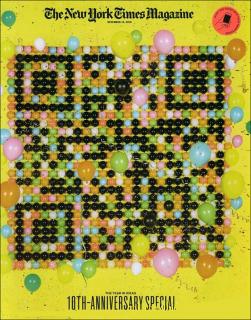Every year Discover magazine lists its 100 Top Science Stories, and a number of these stories, particularly those involving physics and engineering, require a lot of math in their execution. Beyond that, however, four of the stories feature mathematics centrally. In numerical order:
- In #51 A Computer Rosetta Stone we find a computer program that deciphers ancient heiroglyphics statistically. MIT computer scientist Regina Barzilay has developed the program, which compares unknown letters and words to letters and words of known languages in order to find parallels. When she tested it by seeing how much of ancient Ugaritic the program could decipher using the related language Hebrew as the ‘parallel’, the program correctly matched 29 of the 30 Ugaritic letters to their Hebrew equivalent, and 60% of the Ugaratic words that had Hebrew cognates. More importantly, it did the work in a matter of hours, whereas human translators needed decades (and the chance find of an ancient Ugaritic axe that had the word “axe” carved on it) to accomplish similar feats. While the program certainly cannot replace the intuition and feel for language that human scientists possess, “it is a powerful tool that can aid the human decipherment process,” and could already be of use in expanding the number of languages that machine translators can handle.
- #60 Fighting Crime with Mathematics details the work of UCLA mathematicians Martin Short and Andrea Bertozzi who, along with UCLA anthropologist Jeff Brantingham, developed a mathematical model of the formation and behavior of crime ‘hotspots.’ After calibrating the model with real-world data, it appears that hotspots come in two varieties: “One type forms when an area experiences a large-scale crime increase, such as when a park is overrun by drug dealers. Another develops when a small number of criminals—say, a pair of burglars—go on a localized crime spree.” According to the work, the typical police reaction of targeting the hotspots appears to work much better on the first type of hotspot, but hotspots of the second type usually just relocate to a less-patrolled area. As the story notes, “By analyzing police reports as they come in, Short hopes to determine which type of hot spot is forming so police can handle it more effectively.”
- There seems to be a steady stream of stories recently that remark on how some animals instinctively know the best way to do things. One example from this blog is Iain Couzin’s work on animal migration. And here’s another: #92 Sharks Use Math to Hunt. Levy flight is the name given a search pattern which has been long suspected by mathematicians of being one of the most effective hunting strategies when food is scarce. David Sims of the Marine Biological Association of the United Kingdom logged the movements of 55 marine animals from 14 different species over 5,700 days, and confirmed that the fish movements closely matched Levy flight. (The marine animals included tuna and marlin, by the way, but sharks always get the headlines.)
- #95 Rubik’s Cube Decoded covers a story already mentioned on this blog about “God’s Number”, the maximum number of moves that an omniscient being would need in order to solve any starting position of Rubik’s cube. The answer, as you can read in this story or by reading my earlier blog post, is 20.
The whole Top 100 is worth going through as well. It’s remarkable to realize how much and how quickly science is learning in this day and age.





